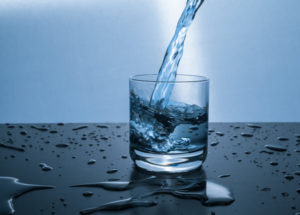WHAT’S IN YOUR WATER
Microplastic particles are already making their way into our water supply – our tap water is teeming with ultra-fine fibres.
Water samples from more than a dozen nations were analysed and 83% were shown to be contaminated with microplastics – the sort used in industries such as cosmetics and biotechnology. The highest rate of contamination (an astonishing 94%) was in the US while the UK rate was 72%. Analysis by Orb Media detected particles of more than 2.5 microns in size; 2,500 times bigger than a nanometre.
A subsequent review found microplastics in more than 90% of the world’s most popular bottled water brands. Plastic is already poisoning our oceans and waterways…is it now poisoning us?
Recently, in Singapore, it was revealed that toxic bacteria had been found on microplastics collected from the Republic’s coastline between April and July 2018: bacteria said to be capable of causing wound infections and gastroenteritis [1].
Another study found microplastics and larger plastic fragments in the digestive tracts of Britain’s marine mammals at every level of the food chain, from minuscule zooplankton to turtles, porpoises and grey seals. [2] In addition to the dangers of mercury, we must also be concerned about plastic in our seafood.
 One line from this report was especially troubling: “A possible relationship was found between the cause of death category and microplastic abundance, indicating that animals that died due to infectious diseases had a slightly higher number of particles than those that died of trauma and other drivers of mortality.”
One line from this report was especially troubling: “A possible relationship was found between the cause of death category and microplastic abundance, indicating that animals that died due to infectious diseases had a slightly higher number of particles than those that died of trauma and other drivers of mortality.”
While the researchers concluded that “further research is required to better understand the potential chronic effects of microplastic exposure on animal health,” the scale of this problem is highly alarming, and the dangers of ingesting nano-scale plastic particles throughout one’s lifetime – both from drinking water and eating seafood – warrant closer attention.
Potentially pathogenic bacteria is only one concern people may have about drinking plastic-laced water. Plastic is composed of major toxic compounds known to cause illness, including the dreaded endocrine disruptor BPA. What’s more, microplastics absorb toxic chemicals from the environment which are linked to cancer and other diseases.
With the aforementioned Orb Media study showing that microplastic particles can migrate through the intestinal wall, travel to lymph nodes and other organs, and penetrate cells, no-one should be cavalier about the risks associated with drinking tap water. Especially given that, to date, there have been no studies of the effects of microplastic consumption by humans.
Of course, there are other contaminants we may be concerned about. Lead piping still carries water to the tap in older properties throughout many areas of the country, with two-thirds of homeowners said to be unaware of whether their supply is affected [3]. Lead can bioaccumulate in the body and cause symptoms such as stomach pain, constipation, memory problems and infertility. Children and unborn babies can develop learning difficulties from prolonged lead exposure.
Pesticides and herbicides widely used in agriculture also have the potential to befoul our tap water, by making their way into ground or surface water systems that feed drinking water supplies. A 2015 study by the World Health Organisation’s IARC cancer agency found that one such herbicide, Glyphosate, was “probably carcinogenic to humans.” We are exposed to Glyphosate via the food chain, so it makes sense to filter every possible remnant of it from our water supply.
 Traces of pharmaceutical drugs, meanwhile, can leach into our water systems via lakes, streams and rivers – the result of improper disposal or excretion. Water treatment plants are not legally required to test for, nor filter, pharmaceuticals and researchers are unaware of the consequences of ingesting a cocktail that could include antibiotics, hormonal drugs, antidepressants, painkillers, heart medication, contraceptives and muscle relaxants, particularly over the course of one’s lifetime. It’s possible that this cocktail could have a harmful compound effect. Unfortunately, this area of research is in its infancy.
Traces of pharmaceutical drugs, meanwhile, can leach into our water systems via lakes, streams and rivers – the result of improper disposal or excretion. Water treatment plants are not legally required to test for, nor filter, pharmaceuticals and researchers are unaware of the consequences of ingesting a cocktail that could include antibiotics, hormonal drugs, antidepressants, painkillers, heart medication, contraceptives and muscle relaxants, particularly over the course of one’s lifetime. It’s possible that this cocktail could have a harmful compound effect. Unfortunately, this area of research is in its infancy.
Needless to say, these contaminants should not be showing up in our water at all: no-one expects plastic, Glyphosate, lead and medication to be a byproduct of hydration. Unfortunately, this is not all; there are other elements which can be considered dangerous or potentially dangerous.
Chlorine, for example, is a disinfectant used by water companies to maintain hygienic conditions within the pipe network. When combined with certain organic materials it may form harmful disinfection byproducts (DBPs) such as trihalomethanes (THMs) and volatile organic compounds (VOCs). The adverse health effects of such byproducts are no secret, with many known for their carcinogenic, mutagenic, genotoxic and cytotoxic effects. Chlorine itself can aggravate respiratory conditions and in 2012, chlorine in tap water was linked to an increase in the number of people developing food allergies. [4] There are also concerns about the effect of chlorinated water on beneficial bacteria within the gut.
It should be noted that water companies aim to keep the chlorine level below 1 mg/litre, and many elect to filter chlorine from their tap water entirely.
 Chloramination is yet another method of water treatment widely used in Great Britain. A combination of chlorine and ammonia, this chemical compound lasts longer in the water system than chlorine and has been shown to corrode ageing lead and copper pipes, causing metals to leach into tap water. What’s more, there are fears over the toxic byproducts it may produce, including carcinogens. Many European nations, including France and Germany, have rejected the process, as have some states in the US. [5]
Chloramination is yet another method of water treatment widely used in Great Britain. A combination of chlorine and ammonia, this chemical compound lasts longer in the water system than chlorine and has been shown to corrode ageing lead and copper pipes, causing metals to leach into tap water. What’s more, there are fears over the toxic byproducts it may produce, including carcinogens. Many European nations, including France and Germany, have rejected the process, as have some states in the US. [5]
It would be remiss to omit fluoride from our water safety considerations. It, too, has been banned by many countries throughout Europe, including Germany, Sweden and Switzerland. Less than 2% of Europe’s population receive fluoridated water via the tap. However, 11% of the UK population continues to receive artificially fluoridated water, ostensibly for its beneficial effect on teeth. The long-held concern of anti-fluoride campaigners, meanwhile, is that such water could heighten one’s risk of other diseases including cancer. If fluoride is entirely safe, we have to ask why it has been phased out in most of Europe, with new fluoridation schemes regularly met with fierce opprobrium.
The manifold concerns outlined above compel many people to filter their tap water as a matter of course – and who can blame them? A high-quality filter can simultaneously reduce your exposure to trace levels of pesticides, hormones, heavy metals, bacteria, pharmaceutical drugs, microplastics, fluoride, chloramine and chloramine. For example, The Energy Plus [6] is a four-stage under-sink system, it combines a range of filter media such as activated carbon and bioceramic minerals, and has been extensively tested by the University of Edinburgh.
As well as reducing 99% of chlorine, chloramine, lead and herbicides, the filter system also takes care of fluoride (90%), volatile organic contaminants (98%), toxic heavy metals (98%), pharmaceutical compounds (95%) and particulates over 0.1 microns (including microplastics).
Ultimately, the possible threat posed by the pollutants merits further investigation and outdated treatment technologies must be upgraded to protect public health. In the western world, we expect our drinking water to be safe. At present, the only way of assuring a high level of contaminant removal is by using an independent filter system at the point of use.
 ABOUT THE AUTHOR
ABOUT THE AUTHOR
Roddy MacDonald is founder of Water for Health.
REFERENCES
[1] www.straitstimes.com/singapore/environment/toxic-bacteria-found-on-microplastics-around-singapores-coastline
[2] www.nature.com/articles/s41598-018-37428-3
[3] www.bathecho.co.uk/news/community/property-owners-scratch-test-lead-water-pipes-80967/
[4] www.dailymail.co.uk/health/article-2242094/Chlorine-tap-water-linked-increase-number-people-developing-food-allergies.html
[5] www.scotsman.com/news/environment/msps-to-question-scottish-water-chiefs-on-treatment-safety-1-4722472
[6] www.water-for-health.co.uk/energy-plus-water-filter.html

